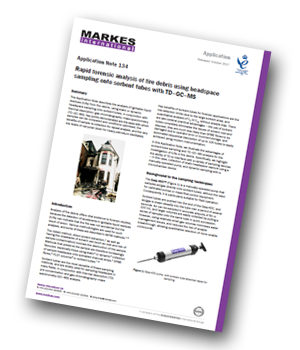Markes International has produced an application note describing the analysis of ignitable liquid residues (ILRs) from fire debris, using static or dynamic headspace sampling onto sorbent tubes, in conjunction with thermal desorption–gas chromatography–mass spectrometry (TD-GC-MS).
 Introduction
Introduction
Analysis of fire debris offers vital evidence to forensic studies, because the detection of accelerants in ILRs can indicate that the fire was not accidental but the result of arson. Various methodologies are used for such analyses, and some of these are described in ASTM methods.
The oldest method, direct solvent extraction, as well as having the drawbacks of solvent use (such as cost and risk of sample contamination) involves the destruction of the sample. Methods that preserve the sample are, therefore, increasingly favoured, especially those using static or dynamic collection of sample headspace onto activated charcoal strips, SPME fibres, PLOT columns or sorbent tubes. Sorbent tubes are the most versatile of these sampling methods, and are widely used for sampling headspace in many fields, in conjunction with thermal desorption (TD) pre-concentration and GC–MS analysis.
In this application note, we illustrate the advantages of sorbent-tube sampling and TD–GC–MS analysis for the investigation of ILRs in fire debris. Specifically, we highlight the ability of TD to interface with a variety of sampling devices – in this case, collection of static headspace vapours using a manually-operated pump, and dynamic sampling with a microchamber device.
Experimental
Samples: Measurements of residual ILRs were performed on (a) wooden dowel, cut into pieces 5 cm long × 0.8 cm diameter, soaked in diesel or petrol (gasoline) and then burnt; (b) cloth soaked in diesel, burnt and then cut into 4 cm × 4 cm pieces. The size of these samples ensured that they fitted easily into the headspace container and microchamber. Samples were analysed as soon as burning was complete.
Results and Discussion
In this section, we look at sample comparison, assessment of sample carryover, sample re-collection and repeat analysis and effect of sampling time. Please download the application note for full details.
Conclusions
In this study, we have shown how headspace sampling onto sorbent tubes, in conjunction with TD–GC–MS analysis, provides an analytically robust, easily optimised way of assessing vapour profiles from fire debris. The key benefits of this approach in a forensic context are the high sensitivity associated with two-stage thermal desorption (TD), and the use of re-collection and repeat analysis to assist the generation of legally defensible evidence. This study also shows that Markes’ TD100-xr thermal desorber is able to analyse ILRs without carryover of high-boiling components, which is reported to be an issue for instruments from other manufacturers.




